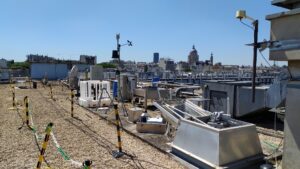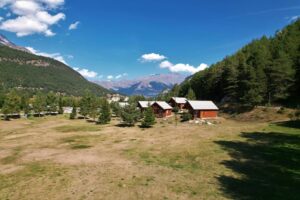Alouestes – Stage 4 : Through the breadbasket of the United States
On May 3rd, 2023, Tiphaine and her travelling companion Glen, landed in Anchorage, Alaska, 7,500 kilometres west – or Alouestes – of France.
Since then, they have been cycling between the Rocky Mountains and the Pacific Ocean, heading south towards a destination that is still unknown. From stage to stage, the duo stopped at breathtaking places, well preserved or, instead, threatened by human activities. From the frozen ground in the Yukon Valley (Canada), to the immense wheat field that seems to be Washington State (USA) at first glance, via the glaciers and forests of British Columbia (Canada), Tiphaine and Glen’s journey is not just a human adventure, but also a scientific one.
In this fourth episode of Alouestes, quoi de nouveau ?, two scientists, Josué Medellín-Azuara, Associate Professor in the Department of Civil and Environmental Engineering at the University of California, Merced (USA) and Nicolas Vuichard, CEA researcher at the Laboratoire des Sciences du Climat et de l’Environnement (LSCE-IPSL), take a look at the plains of the American West, where wind turbines pierce the golden horizon of wheat fields.
Green and golden tones dominate the countryside landscape between Washington State and California along the American west coast. Fields of wheat as far as the eye can see, wreaths of hazel trees neatly arranged in endless rows… the scale of the agricultural power of the United States – the world’s second-largest producer after China, but the largest exporter of agricultural products – unfolds in front of Tiphaine’s camera lens.
Thanks to favourable weather conditions and natural irrigation, agriculture has developed without many obstacles in this part of the country, covering an ever-increasing portion of land. Today, anthropic pressure and the growing impact of climatic hazards are sparking debate about whether this industrial agriculture model should be maintained or transformed.
“The agricultural sector is both a net contributor of greenhouse gases and also strongly impacted by climate change. Events such as heatwaves, droughts and extreme rainfall hit crop growth at key moments”, explains Nicolas Vuichard, a CEA researcher at the LSCE and a specialist in carbon and nitrogen flows, particularly in agricultural ecosystems and areas under heavy human pressure.
He adds: “A second major issue is the need for space and competition for land use linked to agricultural activity. We are increasingly moving towards the optimisation and diversification of surface areas, as shown by the installation of wind turbines and solar panels amidst fields”.
This trend is already affecting some regions of the American West, where wind turbine masts are growing among the heads of wheat. “In the states of Washington, Oregon and California, agriculture is essentially industrial, but the agricultural landscape is changing rapidly. Several factors are driving this change: a growing population, greater demand for agricultural products, the need for renewable energy”, says Josué Medellín-Azuara, Associate professor at the University of California.
Water management and the reduction in greenhouse gas emissions are also essential in the context of climate change.
Photo Gallery
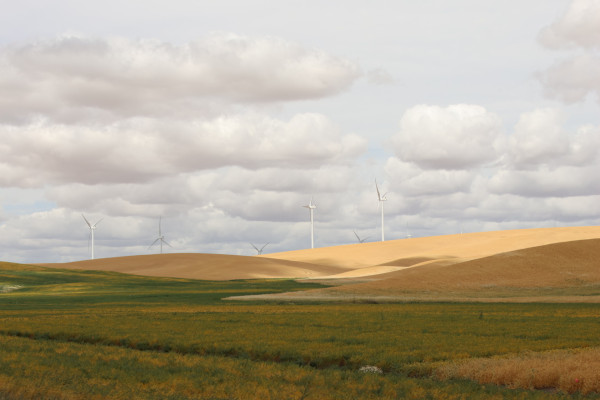
The Palouse region (Washington), with its beautiful hills covered in wheat fields, makes the state one of the major cereal producers in the United States. 25 July 2023 © T.Claveau
Washington State is one of the country’s leading wheat producers, ranking third or fifth depending on the year’s harvest. Agricultural production is driven by global demand for grains and processed food products. In the background, wind turbines can be seen, responding to the need for energy transition that has arisen over the last 20 years. In the hills, there are a few irrigated pastures: cattle are a major consumer of crops.
– J. Medellín-Azuara
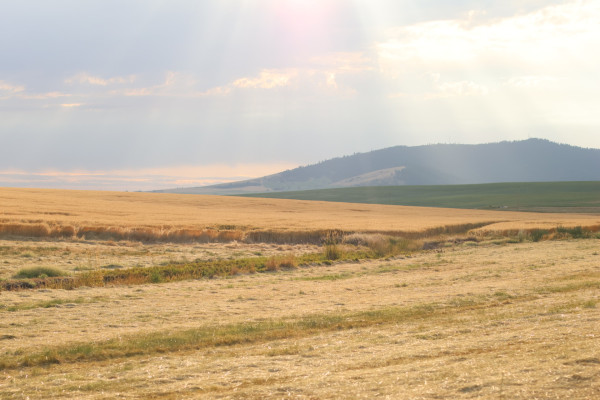
The Palouse region (Washington), with its beautiful hills covered in wheat fields, makes the state one of the major cereal producers in the United States. 25 July 2023 © T.Claveau
The landscape is dominated by large cereal crops. Cultivated land is more damaging in terms of carbon storage than grassland or forests.
– N. Vuichard
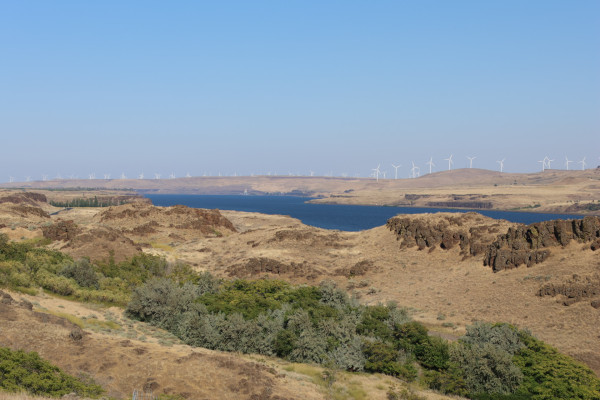
The Columbia River, running along the border between Washington State and Oregon, channels winds that make the land ideal for wind-generated electricity. Near Roosevelt, Washington. 1 July 2023 © T.Claveau
The landscape is fairly uninhabitated: the population is concentrated along the coast, while the hinterland is dominated by agricultural production and energy. Washington State is also the main producer of hydroelectric power in the United States, contributing 27% of the national output thanks to the dams along the Columbia River. This alters the natural conditions for the movement of migratory fish, for example.
– J. Medellín-Azuara
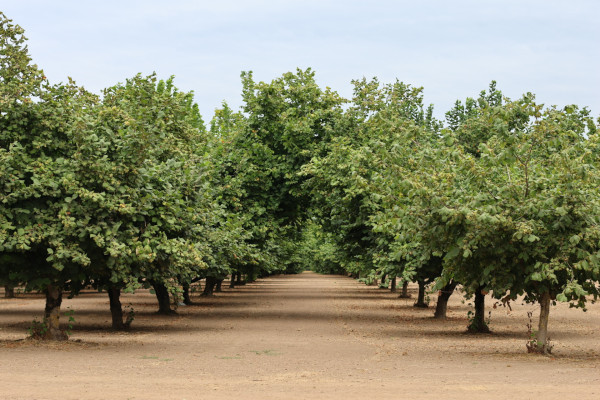
Hazelnut fields near Independence, Oregon. 5 August 2023 © T.Claveau
Oregon accounts for 99% of national hazelnut production (US Department of Agriculture, 2016). Specialisation in a single crop, largely destined for export, raises concerns with the increasing number of climatic hazards. Climate change is making this hyper-concentration of certain crops very fragile, with economic repercussions on a global scale.
– N. Vuichard
These crops are highly mechanised, they do not require a lot of labour and are quite profitable. But irrigation imposes constraints on the water system. The northern territories are water-rich regions, but are affected by droughts. Another problem is that permanent crop footprint is constantly expanding, which reduces the flexibility of water management.
– J. Medellín-Azuara
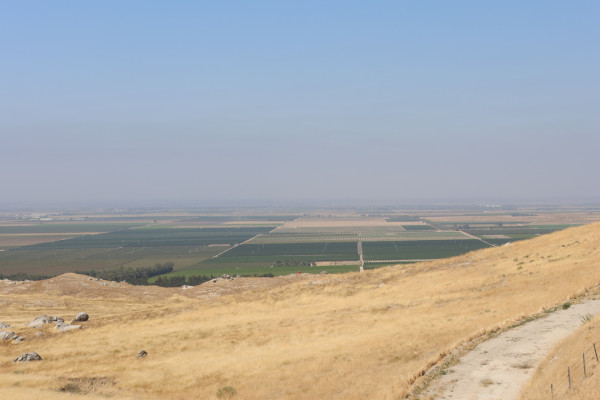
California’s San Joaquin Valley alone produces more than half of the state’s total © T.Claveau
California is a progressive state and attention to water use and emissions regulations is very high. There is, for example, a law requiring monitoring of the hydric balance: underground water reserves are used as a bank account by the concerned operators.
– J. Medellín-Azuara
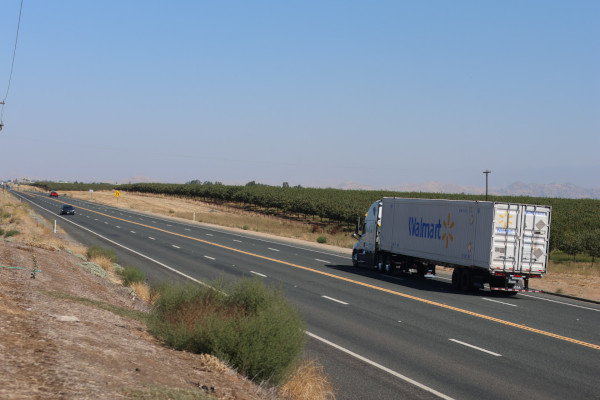
Air pollution is also reaching record levels in this valley, which is bordered to the east by the Sierra Nevada mountains. Bakersfield, California, 4 September 2023. T.Claveau
The Central Valley of California hosts among the most polluted cities in the country (American Lung Association, 2023). This is not only the product of industrialized agriculture, but also of orographic conditions. Also, workers communities surrounded by this industrial agriculture, often host the most vulnerable and low-income population in the State
– J. Medellín-Azuara
Agricultural land emits chemicals that can have an impact on the composition of the atmosphere, for example through the use of certain nitrogen fertilisers. Ammonia emissions have an impact on the formation of fine particles, which are dangerous to health.
– N. Vuichard
Find out more
The first part of Alouestes, Étape 1 : Les sols en dégel entre l’Alaska et le Canada, with scientist Antoine Séjourné.
The second part of Alouestes – Étape 2 : La grande fonte des glaciers nord-américains, with glaciologist Etienne Berthier.
The third part of Alouestes – Étape 3 : Dans le sillage des grands feux, avec Karen Hodges, with Karen Hodges, conservation biologist and ecologist at the University of British Columbia in Kelowna (Canada) and Juan Cuesta, an atmospheric physics researcher at the Laboratoire Interuniversitaire des Systèmes Atmosphériques (LISA-IPSL).
Follow Tiphaine & Glen’s path on Instagram or take a look at their travel blog Alouestes !




